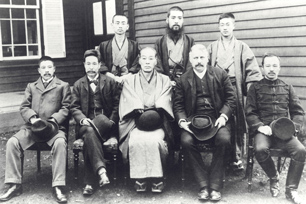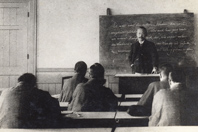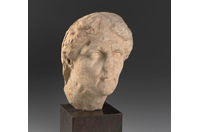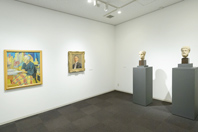The Beginning of Research in Aesthetics and Art History at Keio University
—Ogai Mori’s Shinbigaku (Aesthetics) and Yomokichi Sawaki’s Seiyo Bijutsu-shi (History of Western Art)—
Ogai Mori gives lectures on shinbigaku in 1892

At Keio’s Faculty of Letters, Bigaku Bijutsu-shi [aesthetics and art history] program is translated as Aesthetics and Science of Art. The Japanese word for aesthetics is bigaku and it was also translated as shinbigaku in the earlier days. Academically, aesthetics is a branch of philosophy that explores and sheds light on the nature and structure of beauty.
Keio University is a pioneer in the field of aesthetics and art history. Education in aesthetics at the university began in 1892 when Ogai Mori(Rintaro Mori) initiated a course on shinbigaku, basing the lecture content on the theory of German philosopher Eduard von Hartmann. Ogai is best known for his novels such as Maihime (Dancing Girl) and Takasebune (The Takase boat), but as an aesthetician, he was greatly influenced by Hartmann’s writings and his publications also include Shinbi Koryo (Outline of aesthetics [a translation of Hartmann’s Die Philosophie des Schönen]).
In 1899, Ogai, who was also an army doctor, was appointed chief surgeon of the 12th division in Kokura, Kita-Kyushu, and had to discontinue his lectures on shinbigaku to serve in the army, but he became an adviser to the Department of Literature at Keio University in 1910. Ogai contributed greatly to the development of the department by inviting Kafu Nagai to join as faculty member as well as become the chief editor of Mita Bungaku, which he helped to establish later that same year.
Yomokichi Sawaki initiates lectures on seiyo bijutsu-shi (history of Western art) in 1918

Keio Univerisity's legacy as an important center for research in art history rests on the efforts of Yomokichi Sawaki.
Born in 1886 in Funakawa-mura (present Oga-shi), Akita Prefecture, Sawaki transferred to Keio Futsubu School (junior high school) in 1900. After graduating from Keio University's Department of Literature, he was appointed as English teacher at the Futsubu School. In 1912, when he was 27, he departed for Europe to participate in Keio University’s study abroad program that aimed to cultivate faculty members to become the core members of the university. There, Sawaki came into contact with current artistic movements in Berlin and Munich and while focusing mainly on the study of aesthetics, attended lectures on Renaissance art given by the art historian Heinrich Wölfflin. It was also during this period that Sawaki established a close friendship with Wassily Kandinsky, known as a pioneer of modern abstract art.
After the outbreak of the First World War, it was no longer safe for the Japanese to remain in Germany. Sawaki and Shinzo Koizumi, who was also studying abroad, along with others, decided to move to London. After staying in Paris, Sawaki based himself in Florence and Rome and came into direct contact with Italian art.

After returning to Japan in 1916, he continued his research on Renaissance and Greek art, and succeeded Kafu Nagai’s position as chief editor of Mita Bungaku. In November the following year, he published Bijutsu no Miyako (The capital of art), a collection of Sawaki’s accounts and observations of the different European cities he visited and the art he encountered there, written in a literary style filled with passion and enthusiasm.
In 1918, Sawaki began giving lectures on Western art history and two years later, he was appointed professor of the newly established art history program. Besides his lectures at Keio, he also taught classes on Greek art at Tokyo Imperial University (the current University of Tokyo), and left behind a long list of accomplishments in the field of Western art history in Japan.
Sawaki also cultivated numerous scholars in the field. Kenji Moriya (b. 1898) was one of them. Moriya, who was specializing in modern Western philosophy and aesthetics at Keio, was initially more interested in studying Japanese art history. However, influenced by Sawaki, Moriya chose to specialize in Western art history. After the untimely passing of Sawaki at the age of 43, Moriya took over the unfinished translation of Wölfflin’s Kunstgeschichtliche Grundbegriffe (Basic Concepts of Art History), and the book was published in 1936. He later became an associate professor and left Japan in 1939 to study abroad in Germany and was appointed as professor upon his return to Japan just after the end of the Second World War. In 1953, he won high international acclaim through his book, Die Japanische Malerei (Japanese paintings), which was published in Germany.
Moriya and Teizo Suganuma (b. 1900), Moriya’s contemporary who taught the history of Eastern art at Keio during the same period, laid the foundations of the present Aesthetics and Science of Art program which is well known for its research on early modern Japanese paintings, centering on artists of the bunjinga (Chinese paintings by intellectuals) such as Kazan Watanabe and Taiga Ike-no.
Research in aesthetics and art history at Keio University stretches over a century, and it was in 1993 that the Keio University Art Center was established, promoting an even wider dissemination of Keio research in art to the world.



